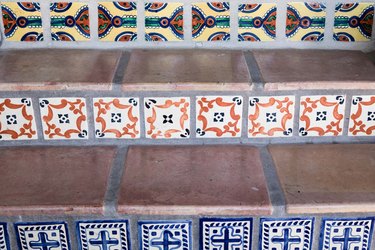
Almost all tile uses grout, whether it's ceramic, porcelain, stone or glass. Tile grout is a viscous liquid material that fills the gaps between tiles (called grout joints) and then hardens to complete the tough, water-resistant surface you expect from tile. Once you've gone through the often agonizing process of selecting just the right wall or floor tile, the next step is choosing a grout. Fortunately, tile grout comes in only a few different types and nowhere near as many colors as tile.
Standard Grouting
Video of the Day
Standard grout is a cement-based product that is made with Portland cement, pigments and various additives to make it more workable and durable. It is the most commonly used type of grout and is the traditional choice for homeowners installing their own grouting tile. It typically is sold as a dry powder that you mix with clean water. The water creates a chemical reaction with the cement in the grout, causing it to harden as the grout cures, much the same way as mortar or concrete.
Video of the Day
Standard grouting is preferred by DIYers (and many tile professionals) because it is relatively inexpensive and easy to work with. The primary drawback to standard grout is that it is porous and susceptible to stains if a sealant is not added after installation and every few years thereafter.
Many grouts sold today are modified with acrylic or latex additives to improve workability and water-resistance and to minimize shrinkage as the grout cures. Formulas without these additives can be mixed with an acrylic liquid, sometimes called grout additive or grout maximizer, instead of water to yield the same benefits.
Sanded Grout versus Unsanded Grout
Standard grout comes in two basic types: sanded grout and unsanded grout. Sanded grout contains fine sand to give the grout body and help it resist shrinkage and cracking on relatively wide grout joints. If your tiles are spaced more than 1/8 inch apart, used sanded grout.
Unsanded grout is almost pure cement and pigments. Use it for tiles with grout joints that are 1/8 inch wide or less. Also, use unsanded grout for all glass tile, as sanded grout can scratch the tile faces. For other types of specialty tile, such as marble, ask your tile supplier for recommendations.

Premixed Acrylic Grout
Premixed grout is sold in sealed plastic tubs and is ready to apply right out of the container. You do not mix it with clean water or other liquids. Premixed grout is an unsanded grout and does not contain cement. It cures through drying rather than chemical reaction. This means that you can cover the tub when you're done and store any unused grout for use later (often up to a year). In addition to convenience, another main benefit of this grout type is that it doesn't need to be sealed because it's not gritty and porous like standard grout.
On the flip side, if you like the natural look and grittiness of cement-based grout, you might not go for the plasticky aesthetic of premixed grout. It also isn't suitable for steam showers or extreme high-traffic areas, like commercial kitchens—although some busy home kitchens might qualify.
Epoxy Grout
Like standard grout, epoxy grout comes in sanded grout and unsanded grout formulas. However, it is not made with cement as a binder. Epoxy grout is made with epoxy resins and a filler powder. And instead of mixing the grout powder with clean water, you mix it with a liquid hardener. The result is an extremely hard, durable grout that is much more water-resistant and stain-resistant than standard cement-based grouts and does not require sealing.
Epoxy grout can be several times more expensive than standard grout and has a well-earned reputation of being harder to work with. However, newer formulas are changing that perception to some degree, offering longer working times and easier cleanup than traditional versions.
Epoxy grout is commonly used in commercial environments, such as hospitals and restaurant kitchens, due to its durability and resistance to chemical cleaners. It is generally considered overkill for household tile installation jobs, but that standard is beginning to change, too. If you're willing to tackle a somewhat fussier material, epoxy grout can be a good choice for heavy-use (and dirty) tile areas like shower floors and kitchen floors and kitchen countertops. Otherwise, it's probably not worth the extra expense and installation trouble.
Note that true epoxy grout is sometimes specified as "100-percent solids." This distinguishes it from a type of hybrid grout called epoxy emulsion that essentially is an epoxy-modified standard grout. Epoxy emulsion grouts do not offer the prized water- and stain-resistance of true epoxy grouts.

Grout Colors
Grout is sold in a variety of colors, the range of which depends on the manufacturer. It's possible to color standard grout by staining it after it is applied (and fully cured), but this has a reputation for causing problems such as inconsistency and splotchiness. Any color-staining also must be done on unsealed grout; once you seal it, coloring is out of the question. So it's best to choose a grout color that you're happy with at the outset. It's also a good idea to test the color by mixing a small amount of grout and letting it dry before you commit to applying it to your tile job. Grout color can change as it dries.
As a final tip, for the best color consistency, mix the dry grout powder in the unopened bag or bucket to distribute the color pigment evenly throughout the powder before you start portioning it out to mix each batch with clean water.
Premixed grout usually looks the same in the container as it does on the tile, but it's not a bad idea to let a small amount dry to confirm the final color. Epoxy grout gets its color from the liquid hardener, so you can't do a test batch—you must open the hardener and mix ALL of it with ALL of the dry powder right away, then apply all of it before the grout sets up.
